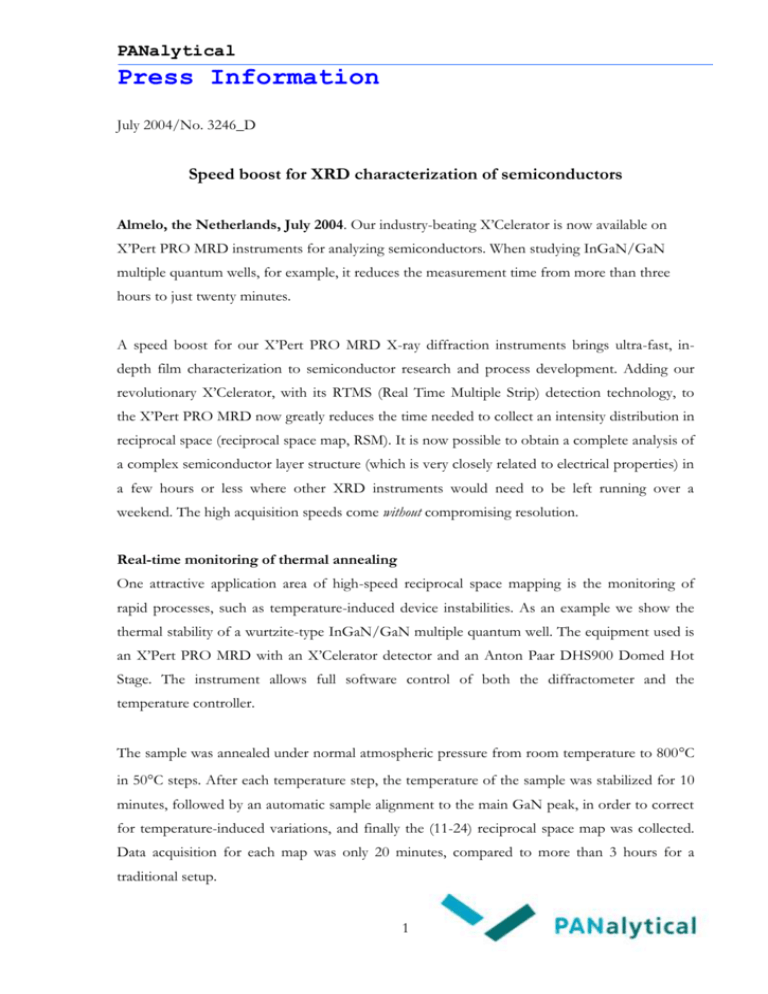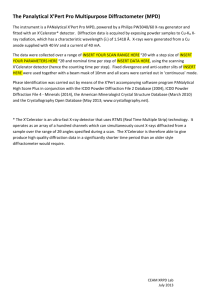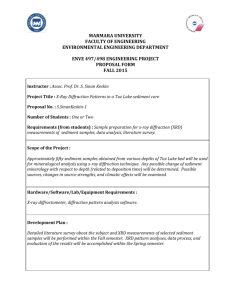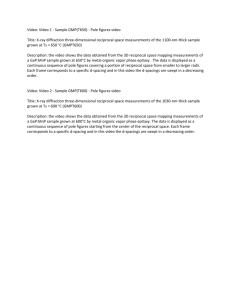PANalytical - Rad Journal
advertisement

PANalytical Press Information July 2004/No. 3246_D Speed boost for XRD characterization of semiconductors Almelo, the Netherlands, July 2004. Our industry-beating X’Celerator is now available on X’Pert PRO MRD instruments for analyzing semiconductors. When studying InGaN/GaN multiple quantum wells, for example, it reduces the measurement time from more than three hours to just twenty minutes. A speed boost for our X’Pert PRO MRD X-ray diffraction instruments brings ultra-fast, indepth film characterization to semiconductor research and process development. Adding our revolutionary X’Celerator, with its RTMS (Real Time Multiple Strip) detection technology, to the X’Pert PRO MRD now greatly reduces the time needed to collect an intensity distribution in reciprocal space (reciprocal space map, RSM). It is now possible to obtain a complete analysis of a complex semiconductor layer structure (which is very closely related to electrical properties) in a few hours or less where other XRD instruments would need to be left running over a weekend. The high acquisition speeds come without compromising resolution. Real-time monitoring of thermal annealing One attractive application area of high-speed reciprocal space mapping is the monitoring of rapid processes, such as temperature-induced device instabilities. As an example we show the thermal stability of a wurtzite-type InGaN/GaN multiple quantum well. The equipment used is an X’Pert PRO MRD with an X’Celerator detector and an Anton Paar DHS900 Domed Hot Stage. The instrument allows full software control of both the diffractometer and the temperature controller. The sample was annealed under normal atmospheric pressure from room temperature to 800C in 50C steps. After each temperature step, the temperature of the sample was stabilized for 10 minutes, followed by an automatic sample alignment to the main GaN peak, in order to correct for temperature-induced variations, and finally the (11-24) reciprocal space map was collected. Data acquisition for each map was only 20 minutes, compared to more than 3 hours for a traditional setup. 1 PANalytical Press Information The stability of the device as a function of temperature was evaluated by calculation of the intensity ratio of the “zeroth” order reflection of the superlattice at elevated temperatures and its value at room temperature. In the figure, this ratio is plotted as a function of temperature. Below 800oC there is only a small drop in the variation of the intensity ratio, caused mainly by the changes of the scattering factors. After 30 minutes annealing at 800oC, the intensity ratio clearly started to drop and after 50 minutes had decreased about fivefold. The intensity of the GaN peak, however, decreased only by 40 % due to the change of the scattering factor. In other words, the superlattice peak is gone, while the substrate peak is still visible: the layer structure is destroyed. Not only for powder diffraction! PANalytical’s revolutionary X’Celerator detector also brings benefits to the high-resolution Xray diffraction analysis of layered structures as encountered in the semiconductor industry by reducing the time needed for recording a reciprocal space map. As a example, we combined the X’Celerator detector with a controlled-temperature device to study the temperature stability of a multi-quantum well structure. Figure: Decrease of the SL0 peak intensity versus annealing temperature. Disordering of the multiple quantum well structure starts at 800oC. 2 PANalytical Press Information Note to the editor PANalytical is the world’s leading supplier of analytical instrumentation and software for X-ray diffraction (XRD) and X-ray fluorescence spectrometry (XRF), with more than half a century of experience. The materials characterization equipment is used for scientific research and development, for industrial process control applications and for semiconductor metrology. PANalytical, formerly Philips Analytical, employs around 750 people worldwide. Its headquarters are in Almelo, the Netherlands. Fully equipped application laboratories are established in Japan, the USA, and the Netherlands. PANalytical’s research activities are based in Almelo (NL) and on the campus of the University of Sussex in Brighton (UK). Supply and competence centers are located in Almelo and Eindhoven (NL). A sales and service network in more than 60 countries ensures unrivalled levels of customer support. The company is certified in accordance with ISO 9001:2000 and ISO 14001. The product portfolio includes a broad range of XRD and XRF systems and software widely used for the analysis and materials characterization of products such as cement, metals and steel, plastics, polymers and petrochemicals, industrial minerals, glass, catalysts, semiconductors, thin films and advanced materials, pharmaceutical solids, recycled materials and environmental samples. Visit our website at www.panalytical.com for more information about our activities. PANalytical is part of Spectris plc, the precision instrumentation and controls company. For more press and product information: PANalytical Marketing Services Dept. Tel: +31 (0)546 534444, Fax: +31 (0)546 534592 E-mail: info@panalytical.com 3






